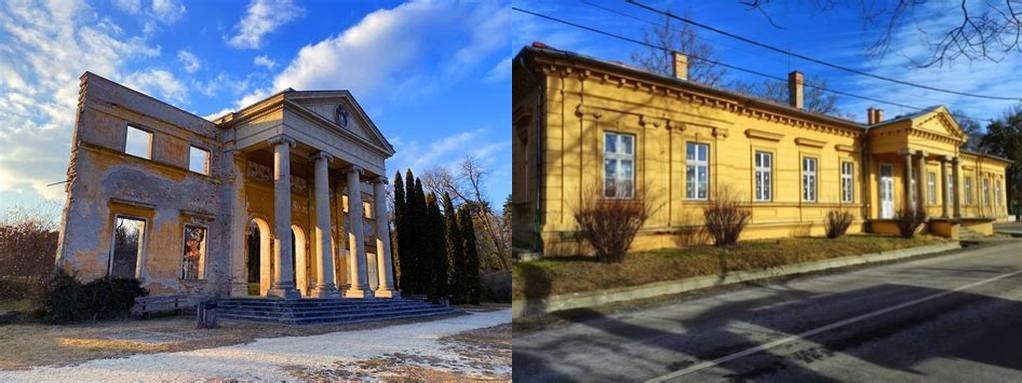
Kóczián-kastély in the quietly enchanting village of Gesztely isn’t the type of mansion that immediately boasts its legacy from a mountaintop. Instead, it nestles discreetly among the rolling northern Hungarian plains, seemingly content to let those who find it savor its understated charm. Approaching the mansion, the trees seem to lean in as if eager to whisper the stories that the walls have stored since the mid-19th century. It’s not the biggest or most extravagant manor house in Borsod-Abaúj-Zemplén County, but perhaps that’s exactly why it’s worth a visit—there’s preservation here, not just of stucco and stained glass, but of a home that has survived the tides of history in its own gentle way.
At the heart of its story is the Kóczián family, whose name the mansion bears. The family rose to local prominence in the 1800s. The mansion itself was completed around 1830, constructed as both a stylish residence and a symbol of the Kócziáns’ growing importance in the region. While Hungarian nobles of the era were often eager to assert their status with all the grandeur that new money could buy, the Kócziáns took a slightly different route, favoring dignified proportions, understated Neoclassical details, and practical layouts—though the wide, light-filled windows and decorative flourishes above the doorways are certainly no less impressive for their restraint. The mansion, a single-story structure, radiates the calm confidence that comes from generations of careful stewardship.
The walls have certainly seen change: a glittering parade of agricultural prosperity punctuated by moments of hardship. When the Kóczián family commissioned the mansion, Hungary was still in the Habsburg Empire, and rural landowners played a pivotal role in local administration and society. The Kócziáns were at the heart of this, hosting gatherings where news from Budapest mingled with local stories beneath the painted ceilings. During the short burst of revolution in 1848, when Hungary briefly asserted its independence, or during the darker years of the world wars and socialist reorganization, the mansion stood witness as the fortunes of its residents—and the nation—shifted. It endured expropriation and multiple repurposings; at various points, the building has served as a community center and even a school, reflecting its integration in the lifeblood of the village.
Walk through the mansion’s rooms today, and you don’t just encounter period architecture; you retrace daily rhythms that make history immediate. The entrance lets you imagine gentlewomen adjusting their bonnets in anticipation of guests, children’s laughter echoing down what was once a bustling salon, or estate staff moving quietly about their duties. The graceful main hall, once the epicenter of rural hospitality, now invites visitors to slow down, reflect, and connect with the dusty threads of memory woven into every wooden panel. Light still streams generously through the lofty windows in the late afternoon, as though showing off how open and connected life in a rural mansion could be.
What’s quietly captivating about Kóczián-kastély isn’t a single architectural flourish but the way layers of history have mellowed the site. While some manor houses become frozen dioramas to show off opulent lifestyles, this mansion wears its age as a kind of patina—its gardens, too, are unruly in places, blending old-world landscaping with traces of local flora reclaiming the ground. Wander the grounds and you’ll find old stones bordered by wildflowers, perhaps a memory of long-ago croquet played beneath the shade of mature beeches. Even today, villagers speak about the mansion not as an aloof relic but as a pillar of the community, a place they might still enter during special events or festivals.
Beyond the physical beauty and historical memory, visiting Gesztely and its mansion offers something increasingly rare: a sense of continuity. Many great houses have been turned into formal museums, but Kóczián-kastély retains intimate traces of warmth and adaptability. If you time your visit right, you might luck into a local gathering—perhaps a heritage day or a concert in the time-weathered courtyard—where the mansion once again becomes a vessel for memory, music, and shared experience. There is little formal pomp, but much quiet hospitality and openness; it’s easy to imagine you’re not only a tourist but a guest, welcomed into ongoing stories that began nearly two centuries ago.
Of course, any journey out to a manor like Kóczián-kastély invites more than just admiration for architecture. You’ll leave with a feeling of having slipped inside a living tapestry, hands brushed by the strands of families, workers, and villagers who’ve shaped—and been shaped by—this place. In an era when so much of the past is boxed and curated behind velvet ropes, the mansion in Gesztely gently insists that history works best when it’s lived, remembered, and felt in spaces that breathe. As you step back out beneath the chestnuts and cycling wind, part of you may well hope this corner of Hungary keeps its secrets for a while longer—just available enough for curious souls to stumble across its quietly enduring light.





